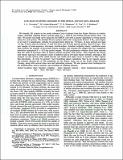Por favor, use este identificador para citar o enlazar a este item:
http://hdl.handle.net/10261/37432COMPARTIR / EXPORTAR:
 SHARE SHARE
 CORE
BASE CORE
BASE
|
|
| Visualizar otros formatos: MARC | Dublin Core | RDF | ORE | MODS | METS | DIDL | DATACITE | |

| Título: | Low-mass Eclipsing Binaries in the Initial Kepler Data Release |
Autor: | Coughlin, Jeffrey L.; López-Morales, Mercedes CSIC ORCID; Harrison, Thomas E.; Ule, Nick; Hoffman, Douglas I. | Palabras clave: | Binaries: eclipsing Binaries: general Stars: fundamental parameters Stars: late-type Stars: low-mass |
Fecha de publicación: | mar-2011 | Editor: | Institute of Physics Publishing | Citación: | Astronomical Journal 141 (3) : 78 (2011) | Resumen: | We identify 231 objects in the newly released Cycle 0 dataset from the Kepler Mission as double-eclipse, detached eclipsing binary systems with Teff < 5500 K and orbital periods shorter than ~32 days. We model each light curve using the JKTEBOP code with a genetic algorithm to obtain precise values for each system. We identify 95 new systems with both components below 1.0 M_sun and eclipses of at least 0.1 magnitudes, suitable for ground-based follow-up. Of these, 14 have periods less than 1.0 day, 52 have periods between 1.0 and 10.0 days, and 29 have periods greater than 10.0 days. This new sample of main-sequence, low-mass, double-eclipse, detached eclipsing binary candidates more than doubles the number of previously known systems, and extends the sample into the completely heretofore unexplored P > 10.0 day period regime. We find preliminary evidence from these systems that the radii of low-mass stars in binary systems decrease with period. This supports the theory that binary spin-up is the primary cause of inflated radii in low-mass binary systems, although a full analysis of each system with radial-velocity and multi-color light curves is needed to fully explore this hypothesis. As well, we present 7 new transiting planet candidates that do not appear among the recently released list of 706 candidates by the Kepler team, nor in the Kepler False Positive Catalog, along with several other new and interesting systems. We also present novel techniques for the identification, period analysis, and modeling of eclipsing binaries. | Versión del editor: | http://dx.doi.org/10.1088/0004-6256/141/3/78 | URI: | http://hdl.handle.net/10261/37432 | DOI: | 10.1088/0004-6256/141/3/78 | ISSN: | 0004-6256 | E-ISSN: | 1538-3881 |
| Aparece en las colecciones: | (ICE) Artículos |
Ficheros en este ítem:
| Fichero | Descripción | Tamaño | Formato | |
|---|---|---|---|---|
| 1007.4295v3.pdf | 17,17 MB | Adobe PDF |  Visualizar/Abrir |
CORE Recommender
SCOPUSTM
Citations
76
checked on 20-abr-2024
WEB OF SCIENCETM
Citations
74
checked on 25-feb-2024
Page view(s)
296
checked on 23-abr-2024
Download(s)
227
checked on 23-abr-2024
Google ScholarTM
Check
Altmetric
Altmetric
NOTA: Los ítems de Digital.CSIC están protegidos por copyright, con todos los derechos reservados, a menos que se indique lo contrario.
